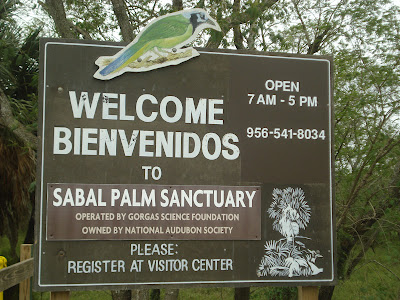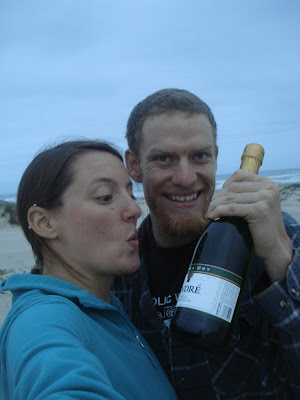Unfortunately, most our days in Brownsville were cloudy and cold. The weather channel forecasted rain every day for the week of our stay, but after 4.5 months, rain or shine, we had to get to the Gulf.
 We took a long scenic route to get out to Boca Chica State Park, an undeveloped park located where the Rio Grande river reaches the Gulf of Mexico. We were especially interested in checking out the border wall in this area, because it often runs quite north of the actual international boundary, placing houses and farms on the south side of the massive fence. And then because there are residents on the other side, there are lots of holes in the fence, to allow the passage of vehicles. So...What is the point of the fence? We weren't the only ones questioning this rational:
We took a long scenic route to get out to Boca Chica State Park, an undeveloped park located where the Rio Grande river reaches the Gulf of Mexico. We were especially interested in checking out the border wall in this area, because it often runs quite north of the actual international boundary, placing houses and farms on the south side of the massive fence. And then because there are residents on the other side, there are lots of holes in the fence, to allow the passage of vehicles. So...What is the point of the fence? We weren't the only ones questioning this rational: |
| Nice sign on our ride out to Boca Chica |
 After riding through some nice residential neighborhoods, we stopped at the Sabal Palm Sanctuary and took a look around. Sabal Palm is a beautiful 527 acre nature reserve which is home to one of the most biodiverse habitats in the United States. It has the last sabal palm forest in the country and is a favorite stop for birders as it is a breeding habitat for many endangered and/or migratory species. Eric and I don't know much about birds, though we enjoyed pointing them out to each other every day of riding, so the only one I can say we saw was the lovely green jay. We hiked around on several of the trails, stopping in a blind on a reseca, visiting the observation deck over the Rio Grande, and we even saw two bobcats on one of the trails! How cool!
After riding through some nice residential neighborhoods, we stopped at the Sabal Palm Sanctuary and took a look around. Sabal Palm is a beautiful 527 acre nature reserve which is home to one of the most biodiverse habitats in the United States. It has the last sabal palm forest in the country and is a favorite stop for birders as it is a breeding habitat for many endangered and/or migratory species. Eric and I don't know much about birds, though we enjoyed pointing them out to each other every day of riding, so the only one I can say we saw was the lovely green jay. We hiked around on several of the trails, stopping in a blind on a reseca, visiting the observation deck over the Rio Grande, and we even saw two bobcats on one of the trails! How cool! |
| wetland bridge in Sabal Palm Sanctuary |
On our way out, we chatted with a couple who was passing through the area and who was really curious about our bike trip and what we thought of the immigration issue. After chatting for several minutes (including getting a good laugh from them when saying the classic "I will believe that corporations are people when Texas executes one of them"), I found out the woman grew up in my hometown, small Minneapolis suburb of Robbinsdale! It really is a small world, folks.
We also asked an employee of Sabal Palm what he thought of the border fence, because Sabal Palm is on the south side of the wall. What he said surprised us: that has actually benefited the park because the animals can still pass through, but southbound Americans can no longer trespass on the property! I don't think that is what ICE had in mind, but it was nice to hear a perk of the border wall!
After Sabal Palm, we stopped by the Lennox Foundation Southmost Preserve, part of the internatioanl Nature Conservancy. The preserve is over 1000 acres and staff there does a lot of work trying to restore the native plant species in the area. We spoke with the Preserve manager, Max Pons, but unfortunately we didn't have enough time to look around.
It was already after 3:00pm and we had 24 miles to bike to get to the beach. This was our last eastward stretch and maybe we should have been savoring it, but it seemed to go on forever! Finally, we saw the end of the road.
On October 6th, 2011 (day 13 of The Trip) we dipped our rear wheels in the Pacific Ocean from the Parque de Las Playas in Tijuana, Baja California.
2600 miles later, on February 7, 2012 (day 137 of The Trip), we dipped our front wheels in the Gulf of Mexico at Boca Chica State Park, Texas (where there was absolutely no one to take a picture of us).
More reflections later, for now, we must celebrate:
 |
| Is that a bottle of Cristal, mi Eric? |
And set up camp on this lonely, barren beach that is such a sight for our sore
We wanted to have a dinner of steak and champagne, but neither of us have much experience cooking meat and we didn't have a cooler so we settled for veggie burgers accompanying our cheap bubbly. It grew dark as we fried up our burgers and took swigs from the Andre bottle and soon enough, we climbed into our tent. Moments later, it began to rain and it continued all night, with the wind pushing our tent from side to side. We awoke to find our things covered with water and sand. One night camping on the beach is always enough.
 |
| beach camping = gross |
The rain had stopped momentarily and we forwent breakfast and scurried around packing as fast as we could. Just a couple minutes before we were ready to pedal back to Brownsville, the drops began to fall. After judgement from so many cyclists, Eric and I had purchased the cheapest, cheesiest rain suits we could for $10 each and as we turned back west, we pulled them on. And inevitably tore them immediately. For the 26 miles back to our hosts' home, the rain fell and we got soaking wet. This was probably the time for us to revel in our accomplishments and reflect on our experience, but all we could do was dream of hot showers and clothes dryers for the two hour jaunt.
But we did it. From Tijuana to Brownsville. We departed. We arrived. I can hardly believe it.













